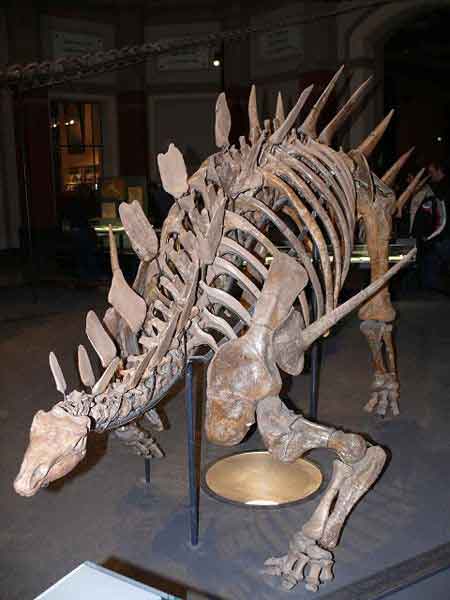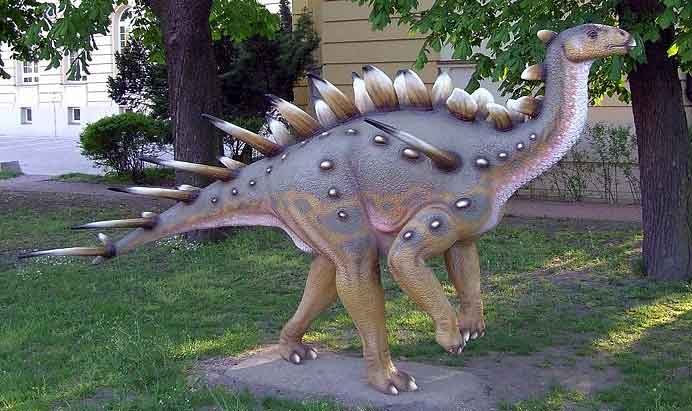
Kentrosaurus aethiopicus, Berliner Naturkundemuseum (*)
| Kentrosaurus Fossil range: Late Jurassic |
||||||||||||||||||
|---|---|---|---|---|---|---|---|---|---|---|---|---|---|---|---|---|---|---|
| Scientific classification | ||||||||||||||||||
|
||||||||||||||||||
| Species | ||||||||||||||||||
|
Kentrosaurus (meaning "pointed lizard"; pronounced /ˌkɛtroʊˈsɔrəs/ KEN-troe-SAW-rus, from the Greek kentron/κεντρον, meaning "point" or "prickle", and sauros/σαυρος meaning 'lizard') is a genus of stegosaurid dinosaur from the Late Jurassic of Tanzania, related to the better-known Stegosaurus of North America.
This 4 meter long stegosaurian was described by Edwin Hennig in 1915. Like Stegosaurus, Kentrosaurus had a double row of plates running down its spine. The two differed in size, in the shape of their armour plating, and in their bodily flexibility, however. The bony plates gave way to spikes about mid-way along the spine. It also had spikes on its flanks.
The ceratopsid dinosaur Centrosaurus from the late Cretaceous period derives its name from the same Ancient Greek words, but the initial letter has changed to a 'C' and is pronounced as a soft C to avoid confusion.
Discovery and species
The 1909–1912 German expedition to East Africa resulted in the discovery of several new dinosaur species, of which Kentrosaurus was one of the most important, for the reason outlined above — it implied a former proximity of Tanzania to the Morrison Formation, in the eastern part of the Rocky Mountains. Of the three paleontologists on this expedition, it was Edwin Hennig who first described Kentrosaurus, in 1915. An almost-complete skeleton was at one time recovered and mounted in the Humboldt Museum, of the University of Berlin but the museum was bombed during World War II and many specimens were lost.
Paleobiology
Kentrosaurus was smaller than Stegosaurus. Kentrosaurus was just 4 metres (16 ft) long and weighed approximately 320 kg.[1] It was certainly small for a stegosaurian.
Armor
Kentrosaurus armor is also rather different from that of Stegosaurus. Kentrosaurus had small dorsal plates along its neck and shoulders. Along the rest of the back and down the tail were several — typically six — spectacular pairs of imposing caudal spikes, each up to a foot in length (see also: Thagomizer). Like other stegosaurs, such as the European Lexovisaurus, it had another pair of spikes jutting backwards from the shoulders (often represented as jutting from the hips in older restorations). Unlike Stegosaurus, which may have used its large plates for thermoregulation, the spines of Kentrosaurus were not well suited to such a function. They could have been used as display features, or armour for self-defence.
Kentrosaurus would have been preyed upon by theropods similar to Allosaurus and Ceratosaurus. It could have used its tail to ward off attacks by lashing the tail from side to side. The spines along Kentrosaurus' flanks would also have helped protect the animal from attacks.
Posture
Kentrosaurus also differed from Stegosaurus in one other key feature — it lacked the pronounced spines on the backbone, near the hip and tail region, that characterize the vertebrae of a Stegosaurus. The length of the thigh bone compared with the rest of the leg indicates that Kentrosaurus was a slow and inactive dinosaur. It may have reared up on its hind legs to reach twigs and leaves, but would normally have been fully quadrupedal.
Environment
The similarities and differences between kentrosaurs and stegosaurs illustrate well the geological principle of continental drift. The similarity between the kentrosaur fossils found in Tendaguru, Tanzania and the stegosaur fossils found in North America are evidence that these two points of the globe, now widely separated, were once very close together and indeed part of a supercontinent, known by geologists as Pangaea and, later, the northern half, known as Laurasia. These two points must also have had very similar climatic conditions, in order to have produced such similar specimens. Meanwhile, the differences between the animals illustrate the changes that their different ancestors underwent divergent evolution as the two groups of animals parted company, because of the subsequent separation of the tectonic plates.

Kentrosaurus aethiopicus, Hennig 1915. Muzeum Geologiczne Państwowego Instytutu Geologicznego. Warszawa (*)
References
* Liddell & Scott (1980). Greek-English Lexicon, Abridged Edition. Oxford University Press, Oxford, UK. ISBN 0-19-910207-4.
1. ^ Seebacher, Frank (2001). "A new method to calculate allometric length-mass relationship of dinosaurs". Journal of Vertebrate Paleontology 21 (1): 51-60.
External links
* Kentrosaurus in The Dinosaur Encyclopaedia at Dino Russ's Lair
Retrieved from "http://en.wikipedia.org/"
All text is available under the terms of the GNU Free Documentation License

